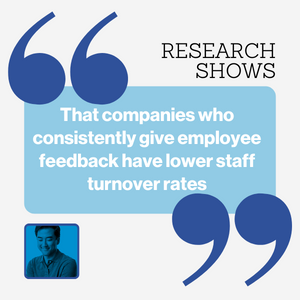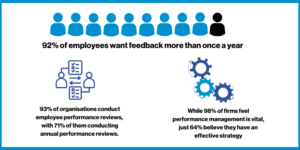 In recent years, there has been much debate about the relevance of performance reviews, with some arguing that in the modern workplace, traditional annual or biannual performance reviews may not be the most effective way to assess employee performance and provide feedback.
In recent years, there has been much debate about the relevance of performance reviews, with some arguing that in the modern workplace, traditional annual or biannual performance reviews may not be the most effective way to assess employee performance and provide feedback.
In an era when many organisations are opting for a system of continuous feedback, allowing for coaching on a regular basis, which enable timely adjustments and improvements, is it time to review the review process?
So, what do the stats tell us?

In addition, employees’ opinions about performance reviews can vary widely based on their individual experiences, the organisational culture, and the specific methods used in the review process.
Feedback is a fundamental tool
While the traditional approach to performance reviews is evolving, the fundamental principles of providing feedback, setting goals, recognising achievements, and supporting employee development remain relevant. Many organisations are adapting their performance management processes to be more agile, continuous, and focused on employee growth, while still retaining these core elements that make performance evaluations valuable.
Reasons why performance reviews still hold significance:
Feedback and Improvement: Performance reviews provide employees with valuable feedback on their work, highlighting their strengths and areas for improvement. This feedback is crucial for personal and professional development, allowing employees to understand their performance from the perspective of their managers and peers.
Goal Setting: Performance reviews often involve setting goals for the upcoming review period. Clear, well-defined goals help employees understand what is expected of them and align their efforts with the organisation’s objectives. Regular performance evaluations provide opportunities to assess progress toward these goals.
Recognition and Appreciation: Performance reviews are an opportunity to recognise and appreciate employees for their hard work and achievements. Positive feedback can boost morale, increase job satisfaction, and motivate employees to continue performing well.
Identification of Training Needs: Performance evaluations can identify areas where employees might need additional training or support. This could include technical skills, soft skills, or leadership abilities. Addressing these needs can enhance overall employee competence.
Decision-making: Performance reviews often play a role in decisions related to promotions, raises, bonuses, and other rewards. They provide a structured way to assess employees’ contributions and make informed decisions about their career progression and compensation.
Legal and Documentation Purposes: Performance reviews serve as a documented record of an employee’s performance, which can be important in legal and administrative situations. They provide evidence of an employee’s work history and can support management decisions in cases of disputes or legal challenges.
Communication and Alignment: Regular performance evaluations facilitate communication between employees and managers. They provide a forum for discussing expectations, addressing concerns, and ensuring that employees understand how their work contributes to the overall goals of the organisation.
Organisational Development: Performance reviews can reveal patterns and trends in employee performance across departments or teams. This information can be valuable for organizational development efforts, helping identify areas for improvement in training, processes, or leadership.
Strategies To Improve the Feedback Process
Establish Clear Communication Channels:
- Ensure there are open lines of communication between employees and managers.
- Encourage regular feedback sessions and make managers approachable for discussions.
Implement Regular Check-Ins:
- Schedule regular one-on-one meetings between employees and their managers.
- Consider weekly or bi-weekly check-ins to provide timely feedback and address issues promptly.
Encourage Peer Feedback:
- Implement 360-degree feedback systems where employees receive input from peers, subordinates, and supervisors.
- Encourage team members to provide constructive feedback to one another in a respectful manner.
Set Clear Objectives and Expectations:
- Ensure employees understand their roles, responsibilities, and performance expectations.
- Set specific, measurable, achievable, relevant, and time-bound (SMART) goals for employees to work towards.
Focus on Strengths and Development Areas:
- Acknowledge employees’ strengths and achievements during feedback sessions.
- Provide constructive feedback on areas where employees can improve and offer support for their development.
Training for Managers:
- Provide training to managers on delivering effective feedback and conducting performance evaluations.
- Teach managers active listening skills and empathy to understand employees’ perspectives better.
Encourage Self-Assessment:
- Allow employees to assess their own performance and reflect on their achievements and challenges.
- Use self-assessments as a starting point for discussions during performance reviews.
Use Performance Management Software:
- Utilise performance management software to streamline the feedback process, track goals, and maintain performance records.
- These tools often provide a centralised platform for feedback and performance-related data.
Recognise and Reward Achievements:
- Implement a system for recognising and rewarding outstanding performance, whether through monetary incentives, awards, or public acknowledgment.
- Positive reinforcement encourages employees to continue their good work.
Encourage a Feedback-Oriented Culture:
Foster a culture where giving and receiving feedback is normal and encouraged.
Reward employees who provide valuable feedback or suggestions for process improvements.
Follow Up:
- Schedule follow-up meetings to discuss progress and assess the effectiveness of the feedback provided.
- Address any challenges faced during the implementation of feedback suggestions.
Continuous Improvement:
- Continuously assess the feedback process for effectiveness and make necessary adjustments based on employee feedback and outcomes.
- Stay updated with industry best practices and adapt your feedback process accordingly.
By implementing these strategies, businesses can create a more transparent, supportive, and productive feedback process that contributes to the growth and development of both employees and the organisation as a whole.
Want to learn more?


